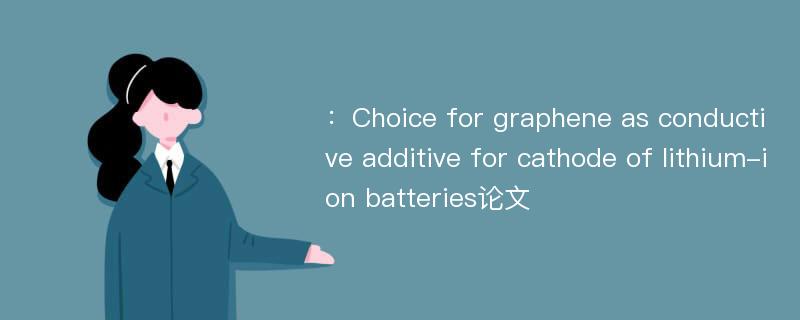
本文主要研究内容
作者(2019)在《Choice for graphene as conductive additive for cathode of lithium-ion batteries》一文中研究指出:Graphene is a promising conductive additive for the lithium-ion batteries(LIBs) and shows great potential especially with its fast development of the large scale fabrication technology. This work has explored the influence of the incorporation of graphenes prepared by three typical methods on the electrochemical performance of the LiCoO2-based cathode focusing on the choice for the effective graphene as conductive additive for the cathode of LIBs. Through the comparison of the intrinsic characteristics of graphenes and the electrochemical performance of electrodes with graphene, it is found that graphene with low disorder degree and large size is not suitable for LiCoO2 cathodes as conductive additive. Conversely, the graphene with oxygen functional groups, relatively low surface area and proper size displays much better electrochemical performance when it is used as conductive additive. This work also demonstrates the transmission mechanism for different graphenes as conductive additives in the LiCoO2 materials, and further reveals that the conductivity of graphene is not the only factor as conductive additives, surface chemistry and sheet size of the graphene are also essential factors which greatly influence the electrochemical performance of electrode. In addition, when combined with Super P, only 1% graphene is enough to construct an efficient conductive network in the electrode. This study also gives a new sight on the practical application of graphene as conductive additive for high performance LIBs.
Abstract
Graphene is a promising conductive additive for the lithium-ion batteries(LIBs) and shows great potential especially with its fast development of the large scale fabrication technology. This work has explored the influence of the incorporation of graphenes prepared by three typical methods on the electrochemical performance of the LiCoO2-based cathode focusing on the choice for the effective graphene as conductive additive for the cathode of LIBs. Through the comparison of the intrinsic characteristics of graphenes and the electrochemical performance of electrodes with graphene, it is found that graphene with low disorder degree and large size is not suitable for LiCoO2 cathodes as conductive additive. Conversely, the graphene with oxygen functional groups, relatively low surface area and proper size displays much better electrochemical performance when it is used as conductive additive. This work also demonstrates the transmission mechanism for different graphenes as conductive additives in the LiCoO2 materials, and further reveals that the conductivity of graphene is not the only factor as conductive additives, surface chemistry and sheet size of the graphene are also essential factors which greatly influence the electrochemical performance of electrode. In addition, when combined with Super P, only 1% graphene is enough to construct an efficient conductive network in the electrode. This study also gives a new sight on the practical application of graphene as conductive additive for high performance LIBs.
论文参考文献
论文详细介绍
论文作者分别是来自Journal of Energy Chemistry的,发表于刊物Journal of Energy Chemistry2019年03期论文,是一篇关于,Journal of Energy Chemistry2019年03期论文的文章。本文可供学术参考使用,各位学者可以免费参考阅读下载,文章观点不代表本站观点,资料来自Journal of Energy Chemistry2019年03期论文网站,若本站收录的文献无意侵犯了您的著作版权,请联系我们删除。
